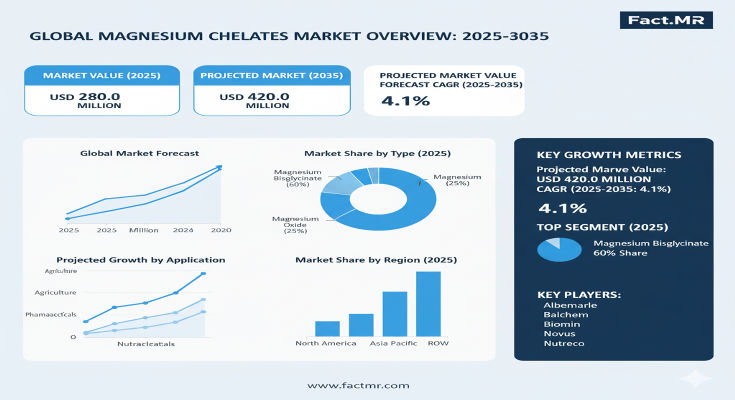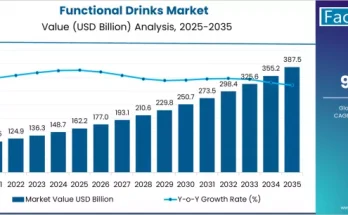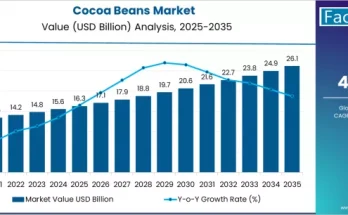As consumers worldwide prioritize nutrient-dense diets and targeted wellness, the magnesium chelates market is gaining traction as a high-bioavailability powerhouse, delivering superior absorption for everything from muscle recovery to bone health. A new report from Fact.MR forecasts the global market, valued at US$ 280.0 million in 2025, to expand to US$ 420.0 million by 2035, reflecting a compound annual growth rate (CAGR) of 4.1%. This 50.0% total growth—unleashing an absolute dollar opportunity of US$ 140.0 million—highlights the sector’s pivotal role in addressing magnesium deficiencies amid aging populations and active lifestyles.
With glycinate variants leading for their gentle efficacy and dietary supplements dominating applications, magnesium chelates are evolving into must-have ingredients in premium nutraceuticals. “Magnesium chelates aren’t just supplements—they’re precision-engineered for optimal absorption, with a 4.1% CAGR underscoring their essential place in the wellness revolution,” said Dr. Lila Chen, Lead Nutraceuticals Analyst at Fact.MR. “From India’s booming supplement scene to Europe’s quality-driven formulations, this market empowers brands to meet the call for clean, effective mineral delivery.”
Click Here for Sample Report Before Buying: https://www.factmr.com/connectus/sample?flag=S&rep_id=8757
Key Drivers: Wellness Awareness and Absorption Superiority
The market’s robust expansion is propelled by a confluence of health imperatives and formulation advancements. Foremost is the surge in global health consciousness, with wellness activities and nutritional supplementation driving demand for bioavailable minerals that bypass common absorption barriers. An aging demographic, projected to reach 1.5 billion over-65s by 2050, amplifies needs for bone-supporting and cardiovascular aids, where chelates excel due to their stability and tolerability.
Superior gastrointestinal tolerance and precise dosing in manufacturing further accelerate adoption, particularly in animal nutrition for enhanced livestock performance. Regulatory benchmarks for quality and efficacy are fostering trust, while innovations in sustainable sourcing align with clean-label trends. “The continuing expansion of health and wellness awareness across established and emerging markets is driving demand for high-bioavailability mineral supplement solutions,” Fact.MR notes, emphasizing how chelates’ performance edges out inorganic alternatives. Challenges like raw material volatility and manufacturing complexities persist, but strategic consolidations are smoothing the path.
Segmentation Insights: Glycinate and Dietary Supplements Lead
Fact.MR’s granular segmentation reveals high-potential niches. By type, glycinate commands a 45.0% share in 2025, prized for its gentle absorption and leadership through 2035, ideal for sensitive users. Citrate follows for cost-effective supplementation, while gluconate rises on bioavailability merits, and others emerge in specialized blends.
Application-wise, dietary supplements dominate at 60.0% share, fueled by consumer-led wellness, with animal nutrition surging through 2030 for pet and livestock fortification. Food fortification grows moderately via functional foods, navigating regulatory hurdles.
Form segmentation favors powder at 70.0% share for manufacturing ease, while liquid variants gain for soluble applications.
Regional Dynamics: India’s Surge Challenges U.S. Maturity
Asia-Pacific emerges as the growth vanguard, with India at a blistering 5.5% CAGR, driven by health infrastructure expansions and supplement innovations in Mumbai and Delhi. China follows at 4.6% CAGR, leveraging manufacturing scale in Shanghai for global exports.
North America holds steady, led by the U.S. at 4.0% CAGR, anchored by a robust supplement base in California and New York, where advanced chelated systems thrive. Australia clocks 4.2% CAGR via nutritional tech hubs.
Europe projects balanced progress, with Germany at 3.8% CAGR (US$ 60.0 million in 2025) focusing on premium manufacturing in Frankfurt. The UK (US$ 45.0 million) and France (US$ 35.0 million) emphasize quality compliance, while South Korea (3.5% CAGR) and Japan (3.0% CAGR) prioritize precision—Japan’s shares: dietary supplements 55.0%, glycinate 50.0%.
South Korea mirrors with 65.0% in supplements, unlocking via K-beauty synergies.
Recent Developments: Supply Chain Evolutions and Local Investments
The chelates landscape is consolidating dynamically. In India and China, manufacturers are investing in local facilities for efficient nutritional processing, reducing import dependencies. South Korea’s automation wave counters labor costs, while Japan’s relationship-based partnerships ensure quality consistency. Vertical integrations by majors like BASF absorb volatility, with 2025 eyeing bio-sourced glycinate pilots for sustainability.
Key Players Insights: Integrators and Innovators Shaping Supply
A moderately concentrated field of 15-20 players sees leaders capturing 40-50% via scale and R&D:
-
Albion Minerals: Glycinate pioneer, dominating supplements with bioavailability expertise.
-
Balchem: Focuses on powder forms, expanding animal nutrition via U.S. integrations.
-
BASF: Premium citrate leader, emphasizing European regulatory compliance.
-
DSM: Multi-grade processor, co-developing for food fortification.
-
Gadot Biochemical: Cost-effective gluconate supplier, targeting Asia-Pacific.
-
Jost Chemical: Specialty developer for liquid variants.
-
NutraScience Labs: Custom blends for U.S. wellness brands.
-
Titan Biotech: Indian innovator in affordable chelates.
- Jungbunzlauer: Sustainable sourcing focus for Europe.
-
BioCare, Novotech Nutraceuticals, Innophos, Kemin, Puris, Valensa: Niche players in animal and functional foods, via partnerships.
Strategies span long-term contracts for globals and custom R&D for specialties, with M&A accelerating verticalization.
Challenges and Opportunities: Volatility vs. Premium Potential
Raw material fluctuations—up 10-15% from supply disruptions—and technical complexities in scaling chelation processes challenge margins, particularly for niche gluconates.
Yet, opportunities gleam: dietary supplements unlock US$ 252.0 million by 2035, glycinate US$ 189.0 million, and India’s growth US$ 20+ million. Bio-based innovations add US$ 10-15 million, while animal nutrition US$ 84.0 million—fertile ground for agile entrants.
Browse Full Report: https://www.factmr.com/report/magnesium-chelates-market
Future Outlook: A $420 Million Boost for Bioavailable Wellness
By 2035, Fact.MR envisions magnesium chelates as a US$ 420.0 million staple, with supplements at 65% share and Asia-Pacific leading adoption. The 4.1% CAGR will prioritize sustainable, personalized nutrition. For stakeholders, the formula is simple: invest in bioavailability to chelate success.



